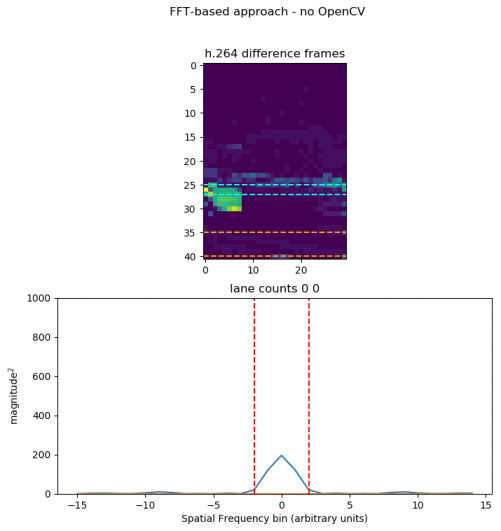-
Notifications
You must be signed in to change notification settings - Fork 8
Home
This miniproject uses a Raspberry Pi Zero W with a PiCamera module to measure relative rate of cars passing by on a street or highway.
The motion vector signal from the PiCamera library is a high SNR signal for stable camera platforms. Cars normally travel in lanes -- a parallel 1-D problem.
Computer Vision and Machine Learning algorithms can be burdensome on a CPU like the Pi Zero W Consider low-dimensional techniques exploiting the observational geometry--this is a first step to almost any remote sensing problem. OpenCV or ML libraries are actually not needed for this problem. The combination of facts below can be exploited with the h.264 motion compression data output for example by the PiCamera library.

A couple things distinctive about traveling automobiles are that they are
- large -- the biggest things moving except perhaps for trains in most cases
- fast -- a lot faster than bicycles and pedestrians except in highly congested areas
Let's assume the automobiles are restricted to a single lane within our field of view. Assuming we're near at a highway interchange or intersection, automobiles tend to stay in their lane. This fact can be exploited to reduce a 2-D spatial problem to an ensemble per-lane 1-D spatial motion measurement.
Assume most of the time the automobiles are moving at a constant rate in the field of view (at least for a given block of time). Perhaps we could eliminate the need to track individual cars if we make our sampling time (frames/second) slow enough so that most of the time, a particular automobile has passed out of the field of view before the next sample (image) is taken?
Many cites and localities are interested in improving public health by encouraging larger proportions of bicycles, scooters, walking and mass transportation vs. automobiles. According to WHO 2016, 92% of the world's population lives in areas with air pollution exceeding WHO limits. One way to understand sources/trends driving local air pollution is by monitoring vehicle traffic vs. time.
Having an inexpensive sensor that could be stuck almost anywhere is useful. It's also useful to have a low cost sensor. An IMX219 camera module is offered for about $8 on Alibaba, and the Raspberry Pi Zero W is widely available for $5. A small 1200 mW solar panel and 5000 mAh battery is available for about $10, so for about $25 in quantity, one might have a widely deployed traffic activity monitor based on the Raspberry Pi Zero W.
This project aims to count automobiles (trucks, cars) over time on city streets near the University.
This project assumes the student will know how to use essential terminal-based programs including ssh.
Due to the limited time for this project, we make simplifying assumptions:
- The system can work only during daylight hours or alternatively night as the algorithms may differ from day to night
- System need only work in one location with a good street/highway view
- a good weather day (no rain, fog etc.)